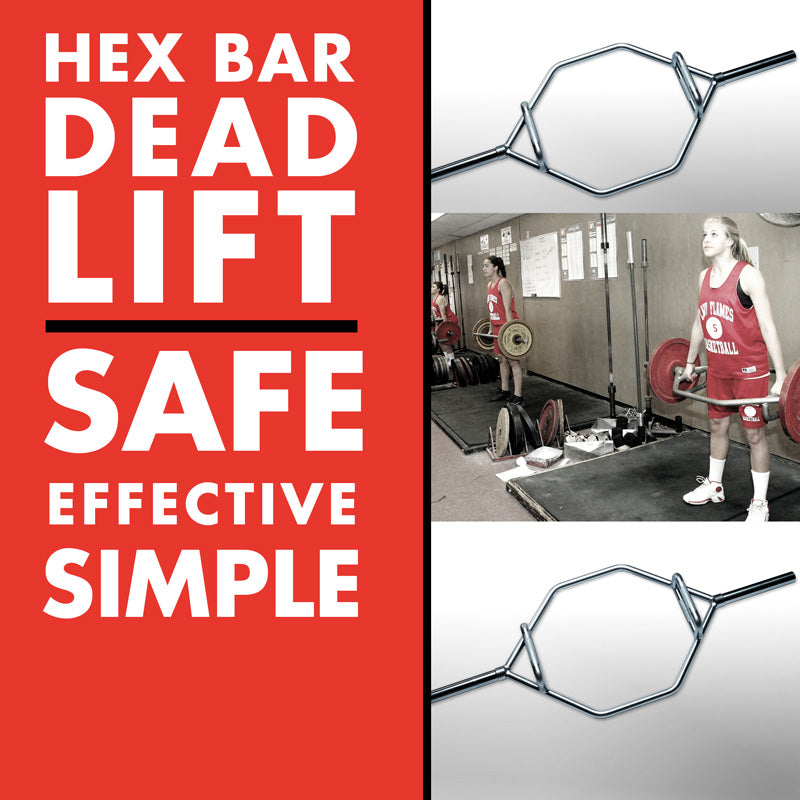A Closer Look at the Hex Bar Deadlift

Another great core lift for the serious athlete
In the early years of BFS we recommended that athletes perform the straight bar deadlift as one of their core exercises to strengthen the lower back, hamstrings, thighs, torso and traps. And although we still like this exercise, we decided to replace it in our program with a better one: the Hex bar deadlift.
The Hex bar deadlift is a deadlift performed with a hexagonal barbell that allows the lifter to perform exercises from inside the encompassing bar. Handgrips strategically placed on the two ends of the bar enable the weight on the bar to be in perfect alignment with the power line at all times.
The power line is an imaginary vertical line that runs through the lifter’s center mass. Executing the deadlift movement along the power line enables the athlete to develop maximum power and reduces risk of injury. The farther the weight diverges from the power line, the more power the lifter loses. For example, how long can you hold a 45-pound bar with your arms straight down and the bar resting against your thighs? Probably for a long time. Now try holding the bar about a foot out from your thighs. Doing that is much harder. The farther away the bar gets from center mass, the harder it is to hold and the more power is lost. In addition, because the Hex bar makes using correct technique easy, a spotter is not necessary.
Quality SOLID BAR bars for 20% off through November 2020! Use discount code 2020SOLID at checkout!
Because the torso is more upright with a Hex bar than with a regular bar, compression forces on the spine and stress on the lower back are reduced. This difference makes it possible for athletes to work the lower back more often every week, whereas such frequency of training with the regular deadlift often causes over training. The Hex bar also lends itself to doing shrugs in a superior way because the bar does not contact the thighs.
The Hex bar is a space saver. It is only 56 inches long, compared with the 86 inches of a regular Olympic bar. This compactness allows placement of many Hex bar stations in a small area. In addition, the shorter length of the bar gives the lifter more control and balance for a more efficient, high-intensity workout.
Hex bar workouts are also fast. BFS Coaches say “The workout took much less time than a squat or deadlift workout would have – only eight minutes. I was extremely sore the next day in my glutes, hamstrings and traps. I could hardly walk. The workout was just like a heavy parallel squat workout when I hadn’t squatted for a while, but my lower back felt great. I was impressed.”
No-Fear Deadlift
Conquering the fear of the deadlift is the purpose of using the Hex bar. The deadlift is a superb exercise for the lower body and torso, but for years fear has overshadowed the great benefits of the deadlift. Coaches and athletes have been leery of the heavy weight and difficult technique associated with the deadlift. The key to conquering this fear is proper technique. As with all lifts, proper technique will eliminate potential injury. With the Hex bar, executing great technique has never been easier. The Hex bar makes doing the deadlift easy and fun for anyone.
To perform the deadlift with the Hex bar or a high Hex bar, the lifter steps into the center of the hexagon and assumes the jump stance. The lifter then squats down and grabs the hand-grips on both sides of the bar, making sure to place the hands squarely in the middle of the handles for balance. The lifter lowers the hips, spreads the chest, locks the lower back in place, keeps the head up with the eyes forward, and puts the knees directly over the feet. The lifter then lifts the bar straight up through the power line using the legs.
Because of the unique design of the Hex bar, the lifter can keep the weight along the power line throughout the entire lift. Once the lifter has stood up completely, the first repetition is complete and the lifter is ready for the next rep. The lifter should proceed to a squat back down, again keeping the lower back locked in, the chest spread and the eyes on target. To minimize back strain, the athlete should use a touch-and-go style between repetitions. Pausing in the down position after each rep is not necessary or desirable. If the bar tends to tilt back and forth during the lift, offset the grip slightly (one hand slightly forward and the other slightly back).
As in all lifts, the head should be up and the chin stretched away from the chest. If the chin touches the chest, the entire body will become dangerously out of position. That technique reduces the amount of weight the athlete can lift and, more importantly, is dangerous and can cause injury to the lower back.
A variation of the Hex bar is the high Hex bar. They are identical except that the high Hex bar has elevated handgrips. The higher starting position allowed by the high Hex bar makes executing exercises easier for beginning lifters and tall lifters. The high Hex bar also provides an excellent way to add variety to workouts.
As with all BFS core lifts, keeping records and setting goals are important. For male athletes, the BFS varsity standard for the Hex bar deadlift or spotted deadlift is 400 pounds, the All-State standard is 500 pounds, and the All-American standard is 600 pounds. Female athletes have a varsity standard of 235 pounds, an All-State standard of 325 pounds and an All-American standard of 415 pounds.
The straight bar deadlift is certainly not a dead exercise and is still performed in powerlifting competition, but the Hex bar deadlift is simply a superior exercise that is much safer to perform. As far as BFS is concerned, the Hex bar deadlift is here to stay!
Quality SOLID BAR bars for 20% off through November 2020! Use discount code 2020SOLID at checkout!

Comments
Lloyd Sisco said:
Where can we purchase Hex Bars?
Steve k said:
Hex Bar links are in the blog post
S